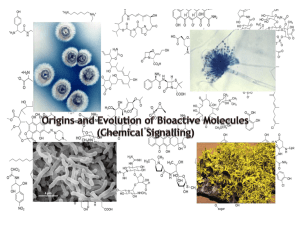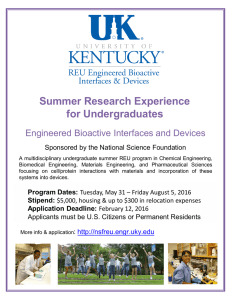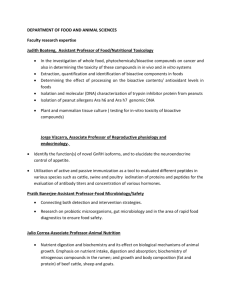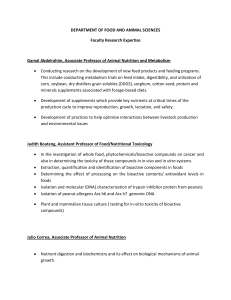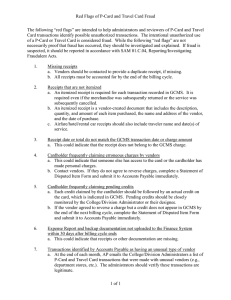Document 13310043
advertisement
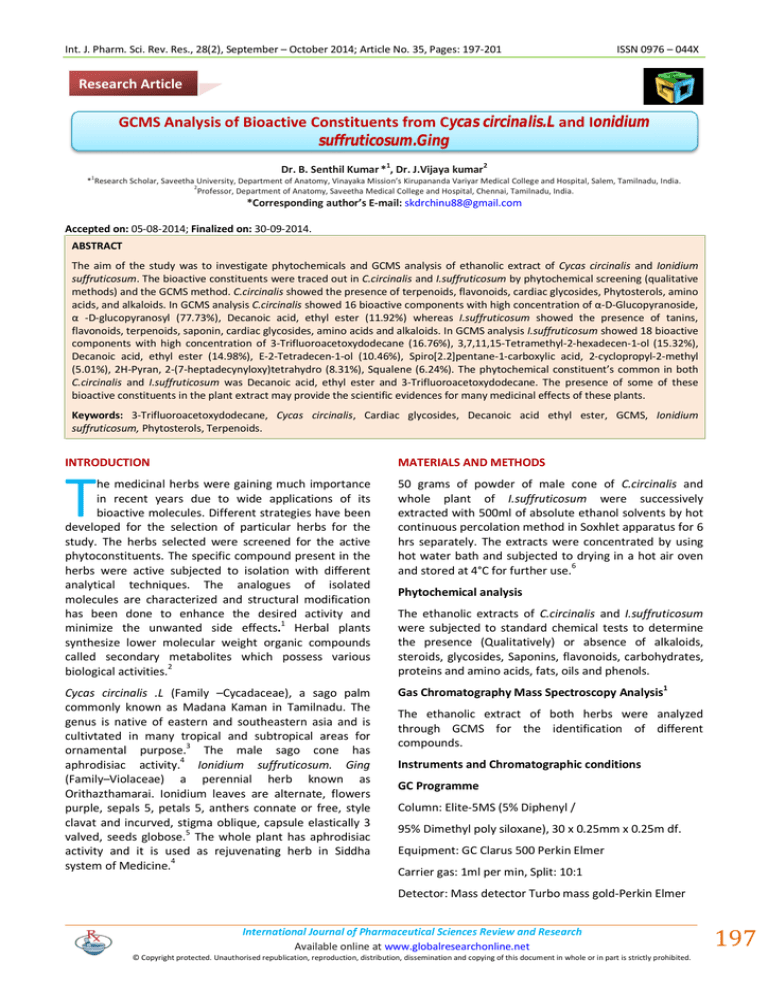
Int. J. Pharm. Sci. Rev. Res., 28(2), September – October 2014; Article No. 35, Pages: 197-201 ISSN 0976 – 044X Research Article GCMS Analysis of Bioactive Constituents from Cycas circinalis.L and Ionidium suffruticosum.Ging 1 Dr. B. Senthil Kumar * , Dr. J.Vijaya kumar 1 2 * Research Scholar, Saveetha University, Department of Anatomy, Vinayaka Mission’s Kirupananda Variyar Medical College and Hospital, Salem, Tamilnadu, India. 2 Professor, Department of Anatomy, Saveetha Medical College and Hospital, Chennai, Tamilnadu, India. *Corresponding author’s E-mail: skdrchinu88@gmail.com Accepted on: 05-08-2014; Finalized on: 30-09-2014. ABSTRACT The aim of the study was to investigate phytochemicals and GCMS analysis of ethanolic extract of Cycas circinalis and Ionidium suffruticosum. The bioactive constituents were traced out in C.circinalis and I.suffruticosum by phytochemical screening (qualitative methods) and the GCMS method. C.circinalis showed the presence of terpenoids, flavonoids, cardiac glycosides, Phytosterols, amino acids, and alkaloids. In GCMS analysis C.circinalis showed 16 bioactive components with high concentration of α-D-Glucopyranoside, α -D-glucopyranosyl (77.73%), Decanoic acid, ethyl ester (11.92%) whereas I.suffruticosum showed the presence of tanins, flavonoids, terpenoids, saponin, cardiac glycosides, amino acids and alkaloids. In GCMS analysis I.suffruticosum showed 18 bioactive components with high concentration of 3-Trifluoroacetoxydodecane (16.76%), 3,7,11,15-Tetramethyl-2-hexadecen-1-ol (15.32%), Decanoic acid, ethyl ester (14.98%), E-2-Tetradecen-1-ol (10.46%), Spiro[2.2]pentane-1-carboxylic acid, 2-cyclopropyl-2-methyl (5.01%), 2H-Pyran, 2-(7-heptadecynyloxy)tetrahydro (8.31%), Squalene (6.24%). The phytochemical constituent’s common in both C.circinalis and I.suffruticosum was Decanoic acid, ethyl ester and 3-Trifluoroacetoxydodecane. The presence of some of these bioactive constituents in the plant extract may provide the scientific evidences for many medicinal effects of these plants. Keywords: 3-Trifluoroacetoxydodecane, Cycas circinalis, Cardiac glycosides, Decanoic acid ethyl ester, GCMS, Ionidium suffruticosum, Phytosterols, Terpenoids. INTRODUCTION MATERIALS AND METHODS T he medicinal herbs were gaining much importance in recent years due to wide applications of its bioactive molecules. Different strategies have been developed for the selection of particular herbs for the study. The herbs selected were screened for the active phytoconstituents. The specific compound present in the herbs were active subjected to isolation with different analytical techniques. The analogues of isolated molecules are characterized and structural modification has been done to enhance the desired activity and minimize the unwanted side effects.1 Herbal plants synthesize lower molecular weight organic compounds called secondary metabolites which possess various biological activities.2 50 grams of powder of male cone of C.circinalis and whole plant of I.suffruticosum were successively extracted with 500ml of absolute ethanol solvents by hot continuous percolation method in Soxhlet apparatus for 6 hrs separately. The extracts were concentrated by using hot water bath and subjected to drying in a hot air oven and stored at 4°C for further use.6 Cycas circinalis .L (Family –Cycadaceae), a sago palm commonly known as Madana Kaman in Tamilnadu. The genus is native of eastern and southeastern asia and is cultivtated in many tropical and subtropical areas for 3 ornamental purpose. The male sago cone has 4 aphrodisiac activity. Ionidium suffruticosum. Ging (Family–Violaceae) a perennial herb known as Orithazthamarai. Ionidium leaves are alternate, flowers purple, sepals 5, petals 5, anthers connate or free, style clavat and incurved, stigma oblique, capsule elastically 3 valved, seeds globose.5 The whole plant has aphrodisiac activity and it is used as rejuvenating herb in Siddha system of Medicine.4 Gas Chromatography Mass Spectroscopy Analysis1 Phytochemical analysis The ethanolic extracts of C.circinalis and I.suffruticosum were subjected to standard chemical tests to determine the presence (Qualitatively) or absence of alkaloids, steroids, glycosides, Saponins, flavonoids, carbohydrates, proteins and amino acids, fats, oils and phenols. The ethanolic extract of both herbs were analyzed through GCMS for the identification of different compounds. Instruments and Chromatographic conditions GC Programme Column: Elite-5MS (5% Diphenyl / 95% Dimethyl poly siloxane), 30 x 0.25mm x 0.25m df. Equipment: GC Clarus 500 Perkin Elmer Carrier gas: 1ml per min, Split: 10:1 Detector: Mass detector Turbo mass gold-Perkin Elmer International Journal of Pharmaceutical Sciences Review and Research Available online at www.globalresearchonline.net © Copyright protected. Unauthorised republication, reproduction, distribution, dissemination and copying of this document in whole or in part is strictly prohibited. 197 © Copyright pro Int. J. Pharm. Sci. Rev. Res., 28(2), September – October 2014; Article No. 35, Pages: 197-201 Software: Turbomass 5.2 ISSN 0976 – 044X flavonoids, saponins, tannin, cardiac glycosides, amino acids and terpenoids (Table 1). Sample injected: 2l Oven temperature Programme - 110° C -2 min hold Table 1: Phytochemical screening Suffruticosum and Cycas circinalis Up to 200° C at the rate of 10° C/min-No hold Up to 280° C at the rate of 5° C / min-9 min hold of Ionidium Parameters C.circinalis I.suffruticosum Phlobatannins - - Injector temperature 250° C Terpenoids + + Total GC running time 36 min Flavonoid + + Tannin - + Saponins - + Cardiac glycosides + + Phytosterols + - Amino acids + + Alkaloids + + MS Programme Library used NIST Version-Year 2005 Inlet line temperature 200° C Source temperature 200° C Electron energy: 70 eV Mass scan (m/z): 45-450 +: Present, - : Absent Solvent Delay: 0-2 min The active constituents with their retention time (RT), molecular weight (MW) Molecular formula (MF), concentration (peak area %) were presented in Table 2 & 3. GCMS analysis of C.circinalis showed 16 bioactive compounds with high concentration of α-DGlucopyranoside, α -D-glucopyranosyl (Trehalose) having retention time (RT) 11.10 and peak area 77.73 %Decanoic acid, ethyl ester (RT 12.72 & 11.92 %) followed by some constituents 3-Trifluoroacetoxydodecane (RT 14.78 & 1.40%) Vitamin d3 (RT 9.51 & 1.04 %) and the rest of the compounds showing peak area ranging from 1.99% to 0.17%, (Table 2). GCMS chromatogram of C.circinalis was shown in Figure 1. Total MS running time: 36 min The extract was dissolve in ethanol and filtered with Elite5MScolumn and analyzed in GCMS for different constituents. The phytoconstituents obtained as a result was interpreted on Mass – Spectrum GCMC using NIST (2005) having more than 62,000 patterns.1 RESULTS C.circinalis showed the presence of secondary metabolites such as alkaloids, flavonoids, terpenoids, phytosterols, cardiac glycosides and amino acids. I.suffruticosum showed the presence of alkaloids, Table 2: Bioactive Constituents of Cycas circinalis Extract by GCMS Analysis No. 1 2 3 4 5 RT 7.29 7.56 9.01 9.51 11.10 Name of the compound 1-(5-Bicyclo[2.2.1]heptyl)ethylamine 1-Adamantanemethylamine, α -methyl3,4-Anhydro-d-galactosan Vitamin d3 α -D-Glucopyranoside, α -D-glucopyranosyl Molecular Formula C9H17N C12H21N C6H8O4 C27H44O C12H22O11 MW 139 179 144 384 342 Peak Area % 1.90 1.99 1.06 1.04 77.73 6 7 8 9 10 12.72 14.78 15.24 19.17 20.58 Decanoic acid, ethyl ester 3-Trifluoroacetoxydodecane Imidazole, 2-amino-5-[(2-carboxy)vinyl]2,6,6-Trimethyl-bicyclo[3.1.1]hept-3-ylamine 1-Methyldecylamine C12H24O2 C14H25F3O2 C6H7N3O2 C10H19N C11H25N 200 282 153 153 171 11.92 1.40 0.33 0.17 0.24 11 12 21.96 23.34 C19H41N C9H16O2S 283 188 0.28 0.31 13 24.71 2-Aminononadecane 1,4-Dioxaspiro[4.5]decane, 8-(methylthio)8,9,9,10,10,11-Hexafluoro-4,4-dimethyl-3,5 dioxatetracyclo[5.4.1.0(2,6).0(8,11)]dodecane C12H12F6O2 302 0.32 14 25.57 C10H14O2 166 0.19 15 27.62 C17H14O7 330 0.54 16 30.78 C13H20O2 208 0.58 Spiro[2.2]pentane-1-carboxylic acid, 2-cyclopropyl-2- methylCyclopenta[c]furo[3',2':4,5]furo[2,3-h][1]benzopyran- 11(1H)one, 2,3,6a,9a-tetrahydro-1,3-dihydroxy-4- methoxy1b,5,5,6a-Tetramethyl-octahydro-1-oxa-cyclopropa[a]inden-6one International Journal of Pharmaceutical Sciences Review and Research Available online at www.globalresearchonline.net © Copyright protected. Unauthorised republication, reproduction, distribution, dissemination and copying of this document in whole or in part is strictly prohibited. 198 © Copyright pro Int. J. Pharm. Sci. Rev. Res., 28(2), September – October 2014; Article No. 35, Pages: 197-201 ISSN 0976 – 044X Table 3: Bioactive Constituents of Ionidium suffruticosum Extract by GCMS Analysis No. RT Name of the compound Molecular Formula MW Peak Area % 1 9.84 Tetrahydro-4H-pyran-4-ol C5H10O2 102 3.75 2 10.95 3,7,11,15-Tetramethyl-2-hexadecen-1-ol C20H40O 296 15.32 3 11.20 Z-1,9-Hexadecadiene C16H30 222 7.31 4 11.40 E-2-Tetradecen-1-ol C14H28O 212 10.46 5 12.71 Decanoic acid, ethyl ester C12H24O2 200 14.98 6 14.80 3-Trifluoroacetoxydodecane C14H25F3O2 282 16.76 7 15.14 Pentadecanoic acid, 2,6,10,14-tetramethyl-, methyl ester C20H40O2 312 1.78 8 17.62 2-Cyclopentene-1-undecanoic acid, (+)- C16H28O2 252 1.09 9 20.57 1-Methyldecylamine C11H25N 171 1.06 10 21.94 2-Aminononadecane C19H41N 283 0.98 11 23.50 Squalene C30H50 410 6.24 12 24.19 3-Hexadecyloxycarbonyl-5-(2-hydroxyethyl)-4-methylimidazolium ion C24H45N2O3 409 1.35 13 25.32 Spiro[2.2]pentane-1-carboxylic acid, 2-cyclopropyl-2-methyl- C10H14O2 166 5.01 14 26.87 5 α -Androstan-16-one, cyclic ethylene mercaptole C21H34S2 350 1.74 15 27.07 2H-Pyran, 2-(7-heptadecynyloxy)tetrahydro- C22H40O2 336 8.13 16 27.80 Bisnorallocholanic acid C22H36O2 332 0.67 17 31.19 1b,5,5,6a-Tetramethyl-octahydro-1-oxa-cyclopropa[a]inden-6-one C13H20O2 208 1.56 18 32.17 Benzeneethanamine, α -methyl-3-[4-methylphenyloxy]- C16H19NO 241 1.79 Figure 1: GCMS Chromatogram of Ethanolic Extract of Cycas circinalis Figure 2: GCMS Chromatogram of Ethanolic extract of Ionidium Suffruticosum I.suffruticosum showed 18 bioactive compounds with high concentration of 3-Trifluoroacetoxydodecane, having retention time 14.80 and peak area 16.76 % 3,7,11,15Tetramethyl-2-hexadecen-1-ol, (RT 10.95 & 15.32 %) Decanoic acid, ethyl ester having (RT 12.71&14.98 %) E-2Tetradecen-1-ol (RT 11.40 and peak area 10.46 %. Followed by four constituents such as 2H-Pyran, 2-(7heptadecynyloxy) tetrahydro (8.13%), Squalene (6.24%). Spiro [2.2] pentane-1-carboxylic acid, 2-cyclopropyl-2methyl (5.01 %), Tetrahydro-4H-pyran-4-ol (3.75%) showed moderate concentration. Nine constituents were least ranging with a peak area from 1.79% to 0.67% (Table 3). GCMS chromatogram of I.suffruticosum was shown in figure 2. DISCUSSION Abeer moawad et al., had done phytochemical investigation on leaflets of C.circinalis and found out new bioflavonoid and in the present study the male cone of C.circinalis showed the presence of flavonoids along with terpenoids, glycosides, Phytosterols, amino acids and alkaloids.3 Ramamoorthy et al., carried out phytochemical investigation on I.suffruticosum showed the presence of alkaloids, glycosides, carbohydrates, steroids, flavonoids, proteins and Coumarins, which goes in hand with the present study showing all phytochemicals and also showed presence of 3 more components which includes 5 terpenoids, tannin and saponins. Trehalose a disaccharide (α -D-Glucopyranoside, α -Dglucopyranosyl) compound in C.circinalis have effects on International Journal of Pharmaceutical Sciences Review and Research Available online at www.globalresearchonline.net © Copyright protected. Unauthorised republication, reproduction, distribution, dissemination and copying of this document in whole or in part is strictly prohibited. 199 © Copyright pro Int. J. Pharm. Sci. Rev. Res., 28(2), September – October 2014; Article No. 35, Pages: 197-201 ISSN 0976 – 044X osteopororsis in a recent research done by Takanobu Higashiyama on the physiological function of trehalose on bone resorption in ovariectomized mice, the trabeculae was significantly decreased when compared to control. In contrast, ovariectomized mice having trehalose did not show any sign of decrease of the trabeculae.7 These results suggest that trehalose might have a kind of suppressive effect on the development of osteoporosis. These results further imply that the daily ingestion of trehalose containing foods could be useful both for prevention of osteoporosis.8 It has been shown that trehalose could protect corneal epithelial cells in culture from death by desiccation and suppress tissue denaturalization.9, 10 compounds followed by its toxicological aspects and clinical trials to come out with safer natural bioactive compounds for the treatment of diseases. 1. Sharangouda J Patil, Venkatesh S, Vishwanatha T, Sneha R. Banagar, Ravikumar J. Banaga, Saraswati B Patil, GCMS Analysis of Bioactive Constituents from the Petroleum Ether Extract of Citrus Medica Seeds, World Journal of Pharmacy and Pharmaceutical Sciences, 3(2), 1239 - 1249. Vitamin d3 is an active compound found in C. circinalis. Various researchers have proved the effect of Vitamin D in male reproductive system. In the genital tract of male rodents, Vitamin D receptor (VDR) has been found in the smooth muscles of the epididymis, spermatogonia, and Sertoli cells, indicating a role of vitamin D in spermatogenesis and sperm maturation in rats.11,12 VDR was detected in human testicular tissue homogenates using titrated vitamin D.13 VDR was detected in human sperm, with binding sites in the nucleus and the midpiece of the sperm.14 VDR and vitamin D metabolizing enzymes were expressed in spermatids, vesicles within the caput epididymis, glandular epithelium of cauda epididymis, seminal vesicle, and prostate.15 Among the other identified phytoconstituents, hexadecanoic acid ethyl ester, have the property of antioxidant activity.16 3Trifluoroacetoxydodecane has antimicrobial and anticancer activity.16 2. Okenwa Uchenna Igwe, Felicia Uchechukwu Okwunodulu, Investigation of Bioactive Phytochemical Compounds from the Chloroform Extract of the Leaves of Phyllanthus amarus by GC-MS Technique, IJCPS, 2(1), 2014, 554-560. 3. Abeer Moawad, Mona Hetta, Jordan K Zjawiony, Melissa R Jacob, Mohamed Hifnawy, Daneel Ferreira, Phytochemical Investigation of Cycas circinalis and Cycas revolute Leaflets: Moderately Active Antibacterial Biflavonoids, Planta Med., 76(8), 2010, 796–802. 4. Murugesa Mudaliar, Siddha materia medica (medicinal plant division), 1996, Herb- 439 & 706. 5. J. Ramamoorthy, R. Meera, P. Devi, Sabarmathy, Phytochemical Investigation and Anti-Inflammatory Activity of Ionodium fructicosum, Asian Journal of Biochemical and Pharmaceutical Research, 2(1), 2011, 142 - 147 6. Senthil Kumar B, Vijaya Kumar J, Selvaraj R, Preliminary Phytochemical Screening of Cycas circinalis (l.) and Ionidium suffruticosum (ging.), International Journal of Pharmacy, 3(3), 2013, 510-513. 7. Takanobu Higashiyama, Novel functions and applications of trehalose, Pure Appl. Chem., 74 (7), 2002, 1263–1269. 8. Nishizaki Y, Yoshizane C, Toshimori Y, Arai N, Akamatsu S, Hanaya T, Arai S, Ikeda M, Kurimoto M, Nutrition Res., 20, 2000, 653–664. 9. Matuo T, Br J Ophthalmol., 85, 2001, 610–612. I.suffruticosum showed the presence of squalene. Squalene has the property of antioxidant activity. Squalene possesses chemo preventive activity against colon carcinogenesis. Antibacterial, antioxidant, antitumor, cancer preventive, immunostimulant, chemo preventive, lipoxygenase-inhibitor, pesticide. Squalene is a hydrocarbon and triterpene.16 It is a natural and vital part of the synthesis of cholesterol, steroid hormones, 18 and vitamin D in the human body. 3,7,11,15Tetramethyl-2- hexadecen-1-ol is a Terpene alcohol possessing antimicrobial, anti-inflammatory activity.16 1(5-Bicyclo[2.2.1]heptyl)ethylamine has antibacterial 19 effect. E-2-Tetradecen-1-ol has antimicrobial activity.20 2H-Pyran, 2-(7-heptadecynyloxy) tetrahydro is a phytoconstituents of Andrographis paniculata which has antimicrobial activity.21 CONCLUSION GC-MS analysis is the initial step for understanding the nature of active principles in the herbs followed by the isolation of individual phytochemical constituent and finding out its biological activity. To conclude the present study, C.circinalis and I.suffruticosum possess various bioactive compounds with pharmaceutical importance. The present research is still under process for its bioactivity and toxicity profile. Isolation of various Acknowledgement: We express our deep sense of gratitude to M/S Colgate Palmolive Private Limited for providing partial financial support to carry out the GCMS analysis. REFERENCES 10. Hirata T, Fukuse T, Liu CJ, Muro K, Yokomise H, Yagi K, Inui K, Hitomi S, Wada H, Surgery, 115, 1994, 102–107. 11. Johnson JA, Grande JP, Roche PC, Kumar R, Immunohistochemical detection and distribution of the 1, 25-dihydroxyvitamin D3 receptor in rat reproductive tissues, Histochemistry and Cell Biology, 105, 1996, 1057– 1115. 12. Merke J, Hu gel U, Ritz E, Nuclear testicular 1,25dihydroxyvitamin D3 receptors in Sertoli cells and seminiferous tubules of adult rodents, Biochemical and Biophysical Research Communications, 127, 1985, 303– 309. 13. Habib FK, Maddy SQ, Gelly KJ, Characterization of receptors for 1,25-dihydroxyvitamin D3 in the human testis, Journal of Steroid Biochemistry, 35, 1990, 195–199. 14. Aquila S, Guido C, Perrotta I, Tripepi S, Nastro A, Ando` S, Human sperm anatomy: ultrastructural localization of 1a,25- dihydroxyvitamin D receptor and its possible role in International Journal of Pharmaceutical Sciences Review and Research Available online at www.globalresearchonline.net © Copyright protected. Unauthorised republication, reproduction, distribution, dissemination and copying of this document in whole or in part is strictly prohibited. 200 © Copyright pro Int. J. Pharm. Sci. Rev. Res., 28(2), September – October 2014; Article No. 35, Pages: 197-201 the human male gamete, Journal of Anatomy, 213, 2008, 555–564. 15. Blomberg Jensen M, Nielsen JE, Jørgensen A, Rajpert-De Meyts E, Kristensen DM, Jorgensen N, Skakkebaek NE, Juul A, Leffers H, Vitamin D receptor and vitamin D metabolizing enzymes are expressed in the human male reproductive tract, Human Reproduction, 25, 2010, 1303–1311. 16. T. Sudha, s. Chidambarampillai, VR Mohan, GC-MS analysis of bioactive components of aerial parts of kirganelia reticulata poir (euphorbiaceae), J. Curr. Chem. Pharm. Sci., 3(2), 2013, 113-122. 17. Meenakshi Sundaram M, Karthikeyan K, Sudarsanam D, Brindha P, Antimicrobial and Anticancer Studies on Euphorbia heterophylla, Journal of Pharmacy Research, 3(9), 2010, 2332-2333. ISSN 0976 – 044X 18. Enas Khalil, Atif Ibrahim, Histological and histochemical Studies of H1N1 Vaccine on Testes of Adult Male Albino Rats, Nature and Science, 9(6), 2011, 58 – 66. 19. Raju G, Subash N, Maridas M, GC-MS Analysis of Chemical Constituents and Antibacterial activity of Indigofera, Nature of Pharmaceutical Technology, 3(2), 2013, 1-5. 20. Osman Ucunc, Tayyibe Beyza Cansu, Turan, Ozdem Ir, Alpay Karao, Glu, Nurettin Yayl, Chemical composition and antimicrobial activity of the essential oils of mosses Turk J Chem, 34, 2010, 825 – 834. 21. Kalaiselvan A, Gokulakrishnan K, Anand T, Gas chromatography-Mass spectrum analysis of bioactive components of the ethanol extract of Andrographis paniculata, Journal of Pharmaceutical and Biomedical Sciences, 20(20), 2012, 1-3. Source of Support: Nil, Conflict of Interest: None. International Journal of Pharmaceutical Sciences Review and Research Available online at www.globalresearchonline.net © Copyright protected. Unauthorised republication, reproduction, distribution, dissemination and copying of this document in whole or in part is strictly prohibited. 201 © Copyright pro

